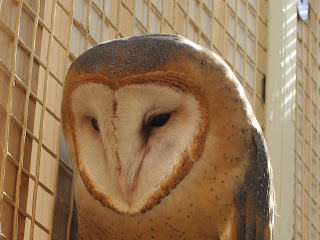Photo by Ken Simms
Anyone who walks at dawn or dusk near Phoenix suburbs will sooner or later be rewarded with the soft, low hoot of a great horned owl. Whether the resonating call of an owl evokes feelings of wild beauty or primeval dread, the sound is always a reminder of something greater than the human world to anyone who pauses to listen. If you're lucky, you may spot the striking silhouette of an owl perched on a saguaro, or see one glide overhead on silent wings.
Among the six species of owl native to the Sonoran Desert (barn, western screech, pygmy, elf and burrowing owls are the others), the hoot of the great horned owl, along with its impressive size, make them easy to identify. Some call them the "5-hooter," since their most common call has five parts, with the second and third hoot more rapid than the rest. With a little imagination, you can hear them say, "Who's awake? Me too!" The female hoots are shorter and higher than the males.
But if you're listening for any of the other desert dwelling owls, don't expect a hoot or even a "who." Listen instead for the "raspy, hissing shriek" of a barn owl, or the "nasal trumpeting" of a burrowing owl. The Western screech owl is reputed for a "spooky wavering tremolo" or "bouncing ball song." An elf owl belts outa duck-like squawk or high barking call. If you hear "monotonous toots, a high rattle or trill," it could be a nearby pygmy owl. Even the great horned owl's repertoire includes a "low, nasal bark," the common response of a female to an amorous male, plus the "high, wheezy bark" of young owlets. (Sibley's Field Guide to Birds of North America, 2000)
At this time of year, the tiny elf owls, smaller than a common house sparrow, have fled to warmer climates south of here for the winter. If they are still hanging around though, you may spot one resting in a cavity in a saguaro or perched in a palo verde tree.
Screech owls and pygmy's are also cavity nesters, using saguaros as well as sycamores, cottonwoods, or any other tree that a woodpecker has excavated and abandoned.
It is true that barn owls like barns and attics of buildings, but they will gladly occupy a box of just the right size if you build them one, as has been done by many and Eagle Scout for their wildlife conservation project.
All of these birds are primarily nocturnal, but it is not uncommon to spot a burrowing owl in broad daylight on golf courses, railroad cuts or anywhere else that there are prairie dog or ground squirrel dens. burrowing owls will dig their own burrows, but also take up residence in those of their prey. their long legs and terrestreial habits are unique among owls.
You can listen to calls of all 200 of the world's owls at: www.owlpages.com/sounds.php
Photos of the screech owl, barn owl and burrowing owl were taken at the Adobe Mountain Wildlife Center in Phoenix, Arizona.



